The Gunslinger is a fascinating stereotype in DnD because it subverts the expectations of typical fantasy D&D campaigns and subjects.
The idea of a character traveling across a fantasy world with technology that is alien to it. However, the Gunslinger rides a fine line between being official content and homebrew.
The Gunslinger Fighter archetype has never been released in an official rulebook or setting supplement. However, it was popularised by the actual play podcast Critical Role, which featured a homebrewed Fighter subclass by Matt Mercer, released on DnD Beyond. Let’s kick off this Gunslinger 5e guide with some key details and an overview of this fighter archetype.
Key Info Up Front
- Book: DnD Beyond Supplement
- Feature Levels: 3, 7, 10, 15, 18
- Roles: Ranged Striker
Gunslinger Overview
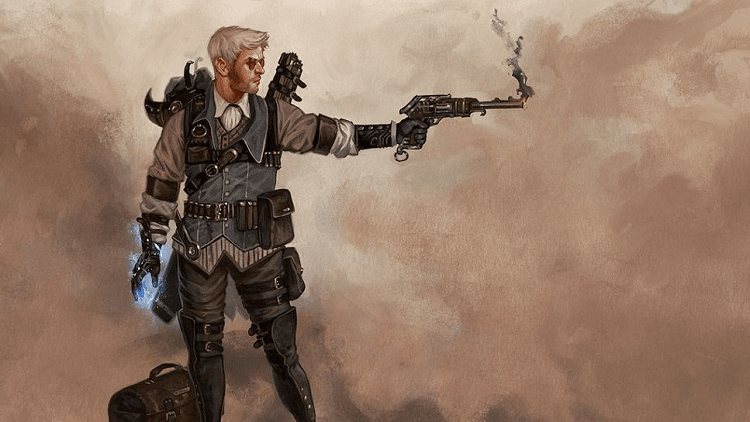
The Gunslinger brings the power of firearms to the fantasy worlds of Dungeons and Dragons. This came after dedicated inventors and alchemists sought to improve upon the common crossbow that had come to dominate martial warfare.
At the same time, they were successful in creating the first firearms that the Forgotten Realms ever saw. However, they have yet to reach the level of production and commonality that bows and crossbows have reached.
This means that Gunslingers have to be good at crafting and maintaining firearms and simply firing them.
They frequently have to create their ammunition and mechanical components, but even then, the imperfect science of firearms still makes them prone to breaking, leaving the wielder vulnerable and weaponless.
While the firearms are operational, they can be some of the most potent ranged weapons in 5e.
Ability Scores
The abilities for this fighter build will end up being a bit different from most subclasses as they focus on Dexterity instead of Strength for their attack rolls. So, you’ll want Dexterity to be your highest Ability from the beginning. After your Dexterity, I recommend investing in your Wisdom.
Perception is usually the most used skill in 5e, and it will be even more useful as a Gunslinger so that you can locate your targets and take them out consistently. Some Gunslighter features also use Wisdom for modifiers, so having a decent modifier will go a long way.
After Wisdom, I recommend focusing on your Constitution to give you a healthy pool of hit points in case you come under fire from ranged enemies.
After your Constitution, you should focus on either Intelligence or Charisma, depending on your character’s background or your party’s needs. You likely won’t fulfill any party roles that rely on these Abilities, so choosing won’t have too much impact on your character.
Finally, have Strength be your dump stat because you should depend solely on Dexterity to deal damage.
Backgrounds
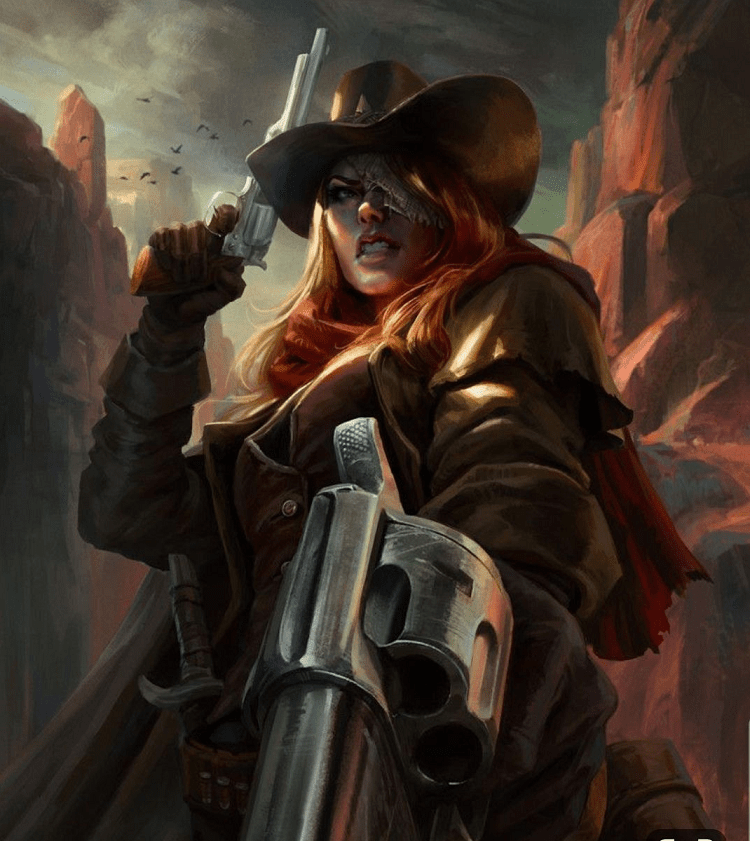
However, there are quite a few options, so you may want to narrow the possibilities by picking the ones that work best with your chosen class.
This can also help if you are having a hard time coming up with a backstory, as starting from the background is an excellent place to begin. So, here are the best backgrounds for the Gunslinger.
- Criminal (Player’s Handbook): This background comes with some handy Dexterity-based skill proficiencies like stealth which you should be strong in thanks to your Gunslinger’s high Dexterity. However, its other skills are focused primarily on Charisma, which isn’t very useful. It also comes with some tool proficiencies, which work well with the Gunslinger’s flavor and can be an exciting start for your backstory.
- Hermit (Player’s Handbook): The Hermit comes with some decent skill proficiencies, but your solid Wisdom should help you get the most out of some of them, like Medicine. It also has an herbalism kit to make potions alongside your firearms and ammunition. The flavor of the Hermit background can also play well into the mystery of the Gunslinger, where they came from, and how they figured out how to make firearms.
- Soldier (Player’s Handbook): Soldier is the default Fighter background, and it is no surprise. It comes with two decent skill proficiencies from the Fighter list and tool proficiencies that make sense with the Gunslinger’s propensity for tinkering and working on things.
- Urban Bounty Hunter (Sword Coast Adventurer’s Guide): Your Gunslinger can use this background well because of its Dexterity-focused skill proficiencies and the option to use thieves’ tools. The concept of a Gunslinger, a fierce bounty hunter, also works exceptionally well and has great potential.
- Urchin (Player’s Handbook): Urchin is a better version of Criminal in that it features similar proficiencies but focuses almost entirely on Dexterity skills without the wasted proficiencies in Charisma skills.
Skills
When you first make your Fighter, you’ll get to choose two skill proficiencies from a list of eight. The skill proficiencies you end up taking will depend on the ones you get from your background and the functions you want your character to fulfill. If you need help picking which order to take skill proficiencies, I recommend this order:
- Perception: Perception is always useful regardless of the character, and with your high Wisdom, you’ll be able to take full advantage of being proficient in it.
- Survival: Another Wisdom skill, Survival can be a real lifesaver, especially when traveling through the wilds throughout your adventures.
- Athletics: While you likely won’t have a Strength core to get the most out of proficiency in Athletics, it can be useful to help you climb to higher areas to get better angles for landing shots.
- Acrobatics: You also will be able to get a lot out of your Acrobatics thanks to your high Dexterity. This can be used to maintain your footing in difficult situations or other uses if you can convince your Dungeon Master to let you.
- History: History is one of the most useful knowledge skills in 5e, and while your Gunslinger won’t be the best at it, being able to gather some more information now and then can be very helpful.
- Intimidation: You should let your party’s Face take care of most situations that would call for an Intimidation or Persuasion check, but having some ability in this area can be helpful if they aren’t nearby.
- Insight: You should also let your party’s Face cover Insight checks for the group, but being able to try yourself can be helpful now and then.
- Animal Handling: Animal Handling likely won’t come up frequently while playing as a Gunslinger unless you want a mount.
Gunslinger Features
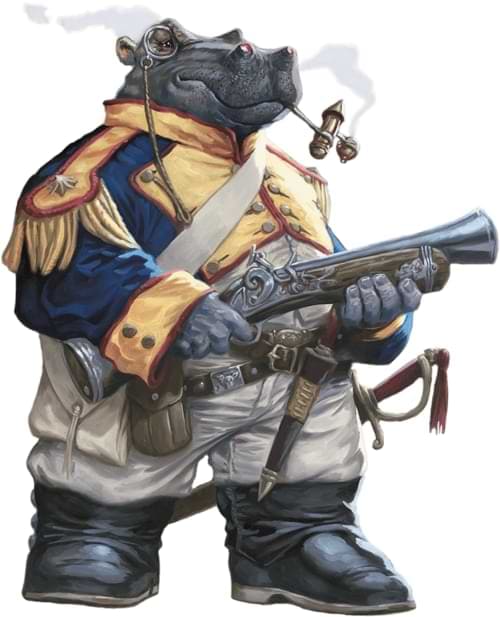
Because of the uniqueness of the Gunslinger subclass, there is a lot to cover regarding its features. So, before getting into the individual features of the subclass that are unlocked by leveling your character up, we first have to look at firearms and the rules DnD Beyond has for firearms.
Firearms
Before your character can craft, equip, and maintain a firearm, we must establish the types, stats, and rules for using firearms. First, all firearms need ammunition to fire, but it can be nearly impossible to find them on sale somewhere.
However, your Gunslinger can craft ammunition using Tinker’s Tools. Each firearm can only use its type of ammunition, so you won’t be able to craft any ammunition that works with multiple firearms.
The Firearms that your Gunslinger will be using also have various properties that are important to understand. The first is their Reload score, which represents how many times they can be spent before you have to use an action to reload the weapon.
To complete the reload, your character has to have a free hand to complete the reload, so there is no pairing a pistol with a shield.
The second property is Misfire, which measures the chance your experimental firearm will malfunction when fired. The firearm being used only misfires if your attack roll is lower than the firearm’s Misfire score, and it is broken if it ever happens.
Once a firearm is broken, it can be repaired with Tinker’s Tools by taking the repair action with a DC of 8 + the weapon’s Misfire score. The final property is Explosive.
This property makes it so that when it is used for a successful ranged attack roll, any target within five feet of them has to make a Dexterity saving throw with a DC equal to 8 + your proficiency bonus + your Dexterity mod. If they fail the saving throw, they are dealt 1d8 fire damage.
Now, we have to look at DnD Beyond’s firearms with the Gunslinger supplement. Of course, if there are none in the list that appeals to you or if you want some more options, you can always talk to your Dungeon Master about homebrewing some more options. These are:
| Firearm | Damage (piercing) | Range | Properties |
| Palm Pistol | 1d8 | Minimum 40 feet
Maximum 160 feet |
Light
Reload 1 Misfire 1 |
| Pistol | 1d10 | Minimum 60 feet
Maximum 240 feet |
Reload 4
Misfire 1 |
| Musket | 1d12 | Minimum 120 feet
Maximum 480 feet |
Two-handed
Reload 1 Misfire 2 |
| Pepperbox | 1d10 | Minimum 80
Maximum 320 |
Reload 6
Misfire 2 |
| Blunderbuss | 2d8 | Minimum 15
Maximum 60 |
Reload 1
Misfire 2 |
| Bad news | 2d12 | Minimum 200
Maximum 800 |
Two-handed
Reload 1 Misfire 3 |
| Hand Mortar | 2d8 Fire | Minimum 30
Maximum 60 |
Reload 1
Misfire 3 Explosive |
Firearm Proficiency
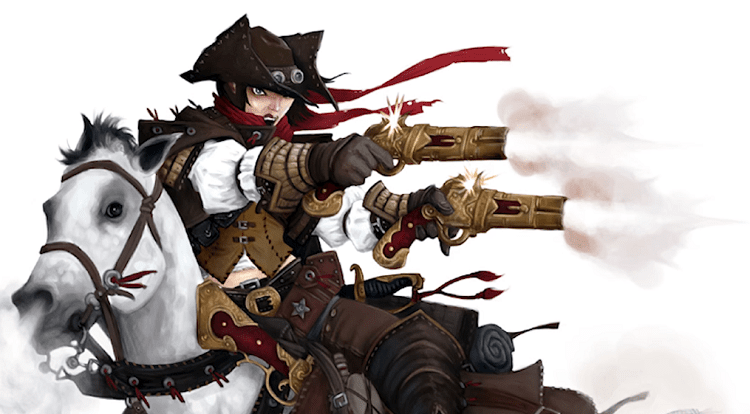
Level: 3
When you take the Gunslinger subclass at level three, you get proficiency with firearms, allowing you to add your proficiency bonus to attacks made with them.
Gunsmith
Level: 3
At level three, you also get proficiency with Tinker’s Tools. These can be used to craft ammunition at half of its normal cost, to craft new firearms, or to repair any that become damaged.
Adept Marksman
Level: 3
The final feature given to Gunslingers at level three is Adept Marksman. This allows you to learn two Trick Shots from the below list. These can be declared whenever you make an attack action with a firearm, and you will learn an additional trick shot at levels 7, 10, 15, and 18.
This feature also gives you Grit points equal to your Wisdom modifier, which are spent to perform one Trick Shot. These are regained completely after a short or long rest, while you’ll also get one back every time you roll a critical attack.
The saving throws of your Trick Shots are equal to 8 + your proficiency + your Wisdom modifier.
Trick Shots
- Bullying Shot: Make an Intimidation check with advantage.
- Dazing Shot: Force an opponent to make a Constitution saving throw on a hit. If they fail the saving throw, they have a disadvantage on attack rolls until their following turn is over.
- Deadeye Shot: Get an advantage on an attack roll.
- Disarming Shot: Try and shoot an object out of a target’s hand. If your attack hits, they have to make a Strength saving throw. Otherwise, they drop the object, and it falls ten feet away from you.
- Forceful Shot: Trip a target and make them fall backward. This forces them to make a Strength saving throw, pushing them fifteen feet away from you if they fail.
- Piercing Shot: Have your bullet go through multiple targets. Doing so adds +1 to the firearm’s Misfire score. Still, after you hit the first enemy, you roll additional attacks to try and hit any enemies in a line behind the initial target with a disadvantage.
- Violent Shot: Allows you to spend as many Grit points as you want to improve the shot. For each Grit point invested, the firearm’s Misfire score for that attack is increased by two and adds one damage die to the attack’s damage roll on a successful hit.
- Winging Shot: Topple a moving target hit with your bullet. This forces the target to make a Strength saving throw and knocks them prone if they fail it.
Quickdraw
Level: 7
The Quickdraw feature gives you two benefits to help you react quickly to combat encounters. This is done by adding your proficiency bonus to your initiative rolls and allowing you to swap firearms with a single Object Interaction during your turn.
Rapid Repair
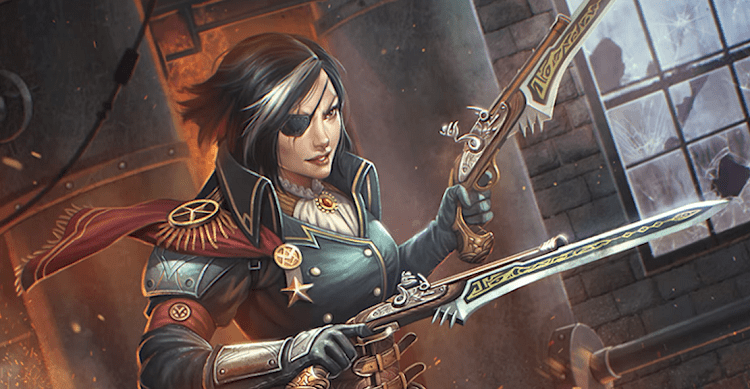
Level: 10
This feature allows you to spend one Grit to attempt to repair a Misfired gun with a bonus action instead of full action.
Lightning Reload
Level: 15
This feature allows you to reload any firearm with a bonus action instead of full action.
Vicious Intent
Level: 18
Vicious Intent increases the range of attack rolls to score a critical hit to include both a natural roll of 19 and 20, allowing you to deal more damage and regain more Grit points.
Hemorrhaging Critical
Level: 18
This feature also improves your critical attack roles by making affected enemies take half the damage they damage they took from the critical attack at the end of their next turn.
Gunslinger Races
When picking a race for your Gunslinger, you can make just about any work, but some are a better fit than others. So, here are my favorite options for rolling a Gunslinger character.
Arakocra
Book: Elemental Evil Player’s Companion
This race comes with solid flight, which will help keep you out of harm’s way and allow you to get the angles required to land shots on essential targets.
It also comes with a bonus to Dexterity, which will help you out. The reprinted version of the Arakocra in Mordenkainen Presents: Monsters of the Multiverse is still a good option but not quite as strong because of its lower speeds.
Bugbear
Book: Mordenkainen Presents: Monsters of the Multiverse
The Bugbear is about optimizing sneak attacks, which the Gunslinger is proficient at getting thanks to its high Dexterity.
Making a Bugbear Gunslinger is a great way to capitalize on the multi-attacks and strengths of the class, allowing you to take down strong enemies before they get a chance to react.
Shadar-Kai
Book: Mordenkainen’s Tome of Foes
The Shadar-Kai comes with a bit of everything a Gunslinger could need. It boosts Dexterity and Constitution as well as the Ability to teleport and reach areas with good sightlines.
Harengon

Book: Mordenkainen Presents: Monsters of the Multiverse and Wilds Beyond the Witchlight
An excellent class for all ranged fighters, the Harengon comes with Rabbit Hop to help you escape melee with just a bonus action or reach higher areas for sightlines.
Some features of the race don’t end up coming in handy too much for Gunslingers, but they still can be situationally helpful.
Gunslinger Feats
Once you start leveling up your Gunslinger, you may want to get your hands on some feats to give yourself more options to take advantage of in combat. My recommendations for the best feats are:
Artificer Initiate
Book: Tasha’s Cauldron of Everything
This feat isn’t usually recommended for Fighters, but it works very well for Gunslingers because they can use tools as a spellcasting focus. It also gives you some great spells to mix up your turns with and fitting in very well with the flavor of your class.
Lucky
Book: Player’s Handbook
The Lucky feat is good on just about any character since it allows you to give yourself an advantage a few times each long rest.
This is especially useful for Gunslingers because it can help you avoid Misfires or having to reload after a missed shot, allowing you to be as impactful on the battlefield as possible.
Piercer
Book: Tasha’s Cauldron of Everything
This perk can be useful to help you bump up your average damage numbers a bit. This can help if you plan on using firearms with big damage dice, but I wouldn’t recommend picking it up until you run out of ability score increases or other feats.
Sharpshooter
Book: Player’s Handbook
This is a must-have for ranged strikers. It will increase your attack rolls with firearms, allow you to shoot from even further away, increase your damage occasionally, and ignore enemy cover. Those benefits can be huge for ranged characters, and the Gunslinger is no different.
Gunslinger Equipment

Regular
You should focus on wearing light armor when it comes to kitting out your Gunslinger. With how high your Dexterity should be, you’ll still have plenty of a chance to avoid the attacks that are made your way.
So, I recommend starting with Leather and then trying to get up to Studded Leather, where you’ll stay for the rest of your campaign.
As for your weapons, I recommend trying out all of the different firearms added with the Gunslinger. Most of the subclass is focused on firing your guns, so you’ll have plenty of opportunities to test them.
Magic Items
Equipping your Gunslinger with magic items tends to be a bit more challenging than other characters because of its strange position as an almost-official subclass.
This means there aren’t as many magic items designed to work with the Gunslinger as there are for other classes. However, there are some that you can keep your eye out for which don’t require any homebrewing by you or your Dungeon Master.
Broom of Flying
Book: Dungeon Master’s Guide
This is your best choice to get a flight if you don’t pick a race that can fly on its own. This will allow you to get high above enemies to get around their cover or focus on high-value targets.
Slippers of Spider Climbing
Book: Dungeon Master’s Guide
This item is the best next thing after being able to fly. They allow you to easily climb walls and ceilings, helping you establish sight lines and get to enemy targets regardless of their battlefield position.
Manual of Quickness of Action
Book: Dungeon Master’s Guide
This magic item gives you a permanent two-point boost to your Dexterity while also increasing your Dexterity cap to 22. Getting a +6 modifier in any skill is useful for players, but it is especially so for Gunslingers as they rely so heavily on firearm attacks.
How to Play a Gunslinger
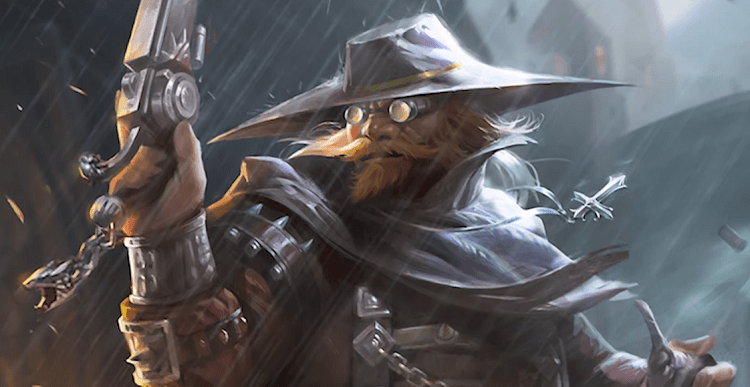
Roleplaying
I think it is pivotal to emphasize their abilities with technology and alchemy when it comes to roleplaying a Gunslinger. They use an extremely rare invention nearly every day, so they must know everything about it.
This is especially true because they must create and maintain their equipment themselves. If there are other Gunslingers in your campaign, whether other players or NPCs, your Gunslinger will likely feel a certain bond with them because of their shared passion.
Depending on the setting of your campaign, you may also come across other technology and magical elements that would spark your Gunslinger’s interest, such as Warforged or other creations.
Playing into this curiosity can be a lot of fun to roleplay while also helping you explore parts of the setting naturally and excitingly.
This can also help motivate your character to go on adventures, whether to test their inventions or to try and find other great works from their fellow inventors.
It is also essential to consider how your character came to be driven to invent firearms and use them. Perhaps they were soldiers who wanted to make more powerful ranged options for regular troops.
Maybe they were given it to them by a mentor who wanted to help keep them safe after they took on a dangerous profession as a bounty hunter. Or, maybe, they were the child of a famous Artificer and became enthralled with the concept of firearms from a young age.
Combat
Once you get into combat, it will be time for your Gunslinger to truly shine. While your character is in combat, you’ll use the same approach for most encounters. Since all your subclass features concern your firearms, you’ll have to play around with them in every encounter.
This has a few implications, such as keeping a backup in case of a misfire, managing your ammunition, keeping good positioning, and good Grit usage.
To do this well, you’ll have to prepare for combat by crafting ammunition whenever you have downtime and keeping your guns in good condition.
Once you get into combat, you will want to get to as high of a position as possible, whether by climbing or flying. This will allow you to control the battlefield by getting around cover and keeping sightlines on essential enemy targets.
Once you get into position, you’ll want to focus on targeting enemies that are either the most vulnerable or present the most value if you kill them.
Knowing which enemy to target can take some time to get used to because it depends a lot on your other party members and what they are capable of or weak to.
Then, you’ll want to reactively use your grit to hinder enemy movements, exploit openings, and deal extra damage when necessary. With this, you should be able to have a big impact on the battlefield despite not having as many options as many other classes.
FAQs
Question: What Book is the Gunslinger in for 5e?
Answer: The Gunslinger has yet to be released in an official book and is instead part of a release exclusive to DnD Beyond.
Question: What are the Alternatives to Playing a Gunslinger in 5e?
Answer: If you can’t play a Gunslinger for any reason, the Arcane Archer or the Artificer and its various subclasses are a strong alternative.
Question: What DnD Settings does the Gunslinger Fit Best in?
Answer: My favorite setting for the Gunslinger is Eberron because of how filled it is with fun magic and mechanical oddities.
The Gunslinger can also fit in the Forgotten Realms or even Spelljammer if your Dungeon Master is okay with making some modifications to the setting.
Conclusion
Before you decide to play a Gunslinger, you need to make sure that your Dungeon Master is okay with it. Since Matt Mercer’s Gunslinger isn’t an official release, they may want to tweak some of its features or may not be comfortable with firearms being introduced to their setting at all.
If they allow it, however, it is a solid ranged Striker class that will give your character a lot of personality. However, if you are looking for a class with many variations or options, you may want to pick a different range option.
- Steel Defender 5e Guide - September 5, 2022
- Harengon 5e Guide - August 24, 2022
- Shambling Mound 5e Guide: The Most Terrifying Plant - August 21, 2022

